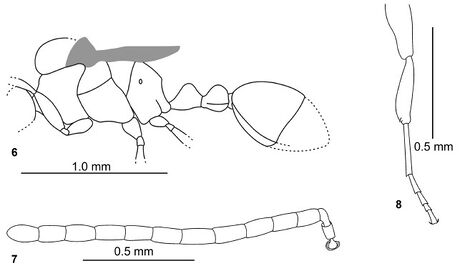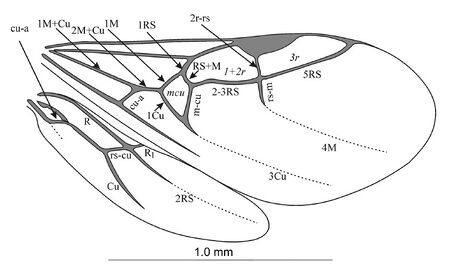Proleptothorax primitivus
| †Proleptothorax primitivus Temporal range: Priabonian, Late Eocene Rovno amber, Ukraine | |
|---|---|

| |
| Scientific classification | |
| Kingdom: | Animalia |
| Phylum: | Arthropoda |
| Class: | Insecta |
| Order: | Hymenoptera |
| Family: | Formicidae |
| Subfamily: | Myrmicinae |
| Tribe: | Crematogastrini |
| Genus: | †Proleptothorax |
| Species: | †P. primitivus |
| Binomial name | |
| †Proleptothorax primitivus Radchenko, Dlussky, & Perfilieva, 2018 | |
Known from a male contained in a piece of Late-Eocene Rovno amber.
Identification
- antennae 13-segmented
- antennal scape very short (SL / HL 0.16, SL / HW 0.18)
- antennal funiculus filiform, without apical club
- length of the second funicular segment subequal to the third one, while distinctly longer than scape, the longest segments are 5th, 6th and 7th
- mandibles short and narrow, bidentate
- forewing with cell 3r closed by vein 5RS
- maxillary palps 5-segmented, labial palps 3-segmented
- scutum with deeply impressed and crenulated notauli
Distribution
This taxon was described from Rovno amber, Baltic Sea region, Europe (Priabonian, Late Eocene).
Biology
Castes
Male
Nomenclature
The following information is derived from Barry Bolton's Online Catalogue of the Ants of the World.
- †primitivus. †Proleptothorax primitivus Radchenko et al., 2018: 113, figs. 1-8 (m.) ROVNO AMBER (Eocene).
Unless otherwise noted the text for the remainder of this section is reported from the publication that includes the original description.
Description
Male
GL 0.06, HL 0.51, HTL 0.27, HW 0.46, ML 0.67, OL 0.24, PH 0.16, PL 0.32, PPH 0.16, PPL 0.16, PPW 0.13, PW 0.11, ScL 0.57, ScW 0.43, SL 0.08. Ratios: GL/OL 0.25, HL/HW 1.12, OL/HL 0.47, PL/HL 0.63, PL/PH 2.00, PPL/PPH 1.20, ScL/ScW 1.34, SL/HL 0.16, SL/HW 0.18.
Total length ca. 2.2 - 2.3 mm. Head slightly longer than wide, widely and gradually rounded above eyes and with strongly convex occipital margin as seen dorsally. Frons slightly longitudinally depressed; frontal carinae and frontal lobes not developed. Distance between antennal insertions 0.08 mm. Torulus subvertical. Clypeal surface gradually convex along its width, without longitudinal carinae, anterior margin of clypeus slightly convex, without medial notch. Eyes large, bulging, their maximal diameter about half of head length, situated distinctly in front of midlength of sides of head, so that temples longer than maximum diameter of eye. Genae very short, four times shorter that maximum diameter of eyes. Ocelli well developed and large, diameter of central ocellus 0.06 mm, distance between posterior ocelli 0.09 mm; lower edge of central ocellus lays slightly posteriorly of imaginary line connecting posterior margins of eyes. Length of mandibles 0.12 mm.
Mesosoma relatively long and rather narrow, scutum quite strongly convex as seen laterally, scutellum much less convex, lays distinctly lower than surface of scutum, scutoscutellar sulcus wide, deep and crenulated. Propodeum angulate, without teeth, its dorsal surface subequal to posterior one. Petiole with quite long peduncle, twice longer than high, anterior surface of petiolar node very weakly concave, posterior one slightly convex, node dorsum widely rounded; postpetiole subglobular. Legs long and slender, femora not swollen. Hind coxae widely separated in ventral view, when coxae directed outward, their inner margins far apart. Pretarsal claws simple. Middle and hind tibiae with short simple spur.
Forewing with closed cells mcu, 1+2r and 3r, cells cua and rm are absent. Pterostigma quite big, somewhat rounded. Cell 3r relatively short, its length subequal to length of cell 1+2r, apex of cell 3r touches wing margin. Cell mcu small, trapezoid, high, its height equal to length of midline, section 2-3RS more than 3 times longer than RS+M. Vein 5RS very feebly curved, almost straight, vein section 2-3RS S-shaped. Cross-vein rs-m merging with vein section 4M at a blunt angle, it diverges with cross-vein 2rrs and vein 5RS from same knot so that vein section 4RS is absent. Vein 3Cu feebly marked, not sclerotized. Wing length 1.87 mm, distance from wing base to pterostigma 0.82 mm. Icu = 1.57, Icua = 1.27.
Hind wing without free section of medial vein, free section of cubital vein (Cu) very slightly curved, almost straight. Cross-vein rs-cu not curved. Veins R, rs-cu, 2RS and R1 diverge from same knot. Cross-vein cu-a located approximately at the midlength between base of wing and branching of rs-cu and Cu. Wing length 1.21 mm.
Since wings of the specimen were somewhat deformed (curved down) during fossilization, the shape of the cells mcu and 1+2r appear slightly distorted.
Head dorsum quite coarsely and densely punctated, frons laterally also with longitudinal striation. Scutum, scutellum, propodeal dorsum waist and gaster smooth and shiny; pronotum, mesopleura and sides of propodeum finely superficially punctated, appears dull. Whole body with quite abundant, thin erect to suberect hairs, scapes and legs with dense decumbent pubescence.
Type Material
Holotype: Institute of Zoology of the Ukranian National Academy of Sciences No. K-26591, male, complete specimen; paratype: SIZK No. K-18699, male, complete specimen. Ukraine, Rovno Prov., vicinity of Klesov. Type horizon: Rovno amber, Late Eocene (Priabonian stage).
The paratype specimen is mostly concealed by turbid film and hardly measurable, though the forewing venation, antennal structure and general shape of the body (in profile) are visible. Its body length is ca. 2.2 mm.
Etymology
From Latin “primitivus” – primitive, primal, which means presence of the many primitive morphological features in this species.
References
- Radchenko, A., Dlussky, G.M., Perfilieva, K. 2018. A new extinct ant genus (Hymenoptera: Formicidae: Myrmicinae) from the Late Eocene Rovno amber – a putative ancestor of the Leptothorax genus group. Myrmecological News, 27: 111-117.



